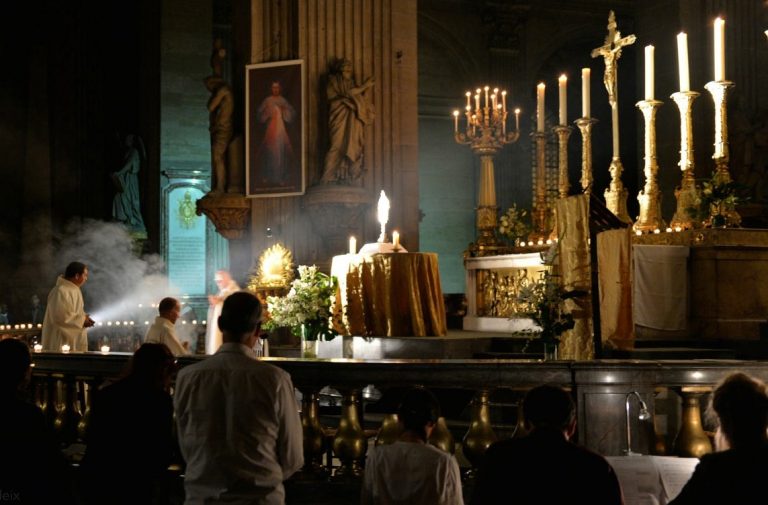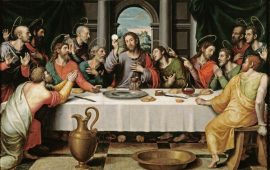By Lawrence Feingold
Dr. Lawrence Feingold is Associate Professor of Theology and Philosophy at Kenrick-Glennon Seminary in St. Louis. He is the author of numerous scholarly books, including The Eucharist: Mystery of Presence, Sacrifice, and Communion, a comprehensive commentary on the mystery of the Eucharist drawing from Scripture, the Church Fathers, and magisterial teaching throughout the ages.

Since Christ is truly present in the Eucharist in His sacred humanity hypostatically united with the divine nature, the Eucharist should receive the adoration of latria that is given exclusively to God. Adoration of Christ in the Blessed Sacrament is a natural consequence of the Church’s faith in the real substantial presence of Christ in the Eucharist.
Adoration corresponds most directly to the first of the three principal purposes for which Christ instituted the Eucharist, which is that Christ wished to perpetuate His adorable human presence among us after ascending definitively into heaven. The Eucharist is the solution to this problem. The divinity of Christ is omnipresent, but, after His Ascension, His humanity is substantially present only in heaven and in the Eucharist. Since the Son of God became man for us and has devised a marvelous way to remain with us in the Eucharist in the substantial presence of His humanity, it follows that adoration of and intimate encounter with Christ in the Blessed Sacrament is not an afterthought, but rather an essential aspect of the Eucharist. As Israel adored the special presence of God (the shekhinah) in the Ark of the Covenant and in the Holy of Holies in the Temple, how could the Church not fittingly adore the substantial presence of Christ, who makes Himself present with much greater generosity in every tabernacle?
Adoration is also intimately related to the other two ends of the Eucharist. Christ is adored in the Eucharist as the sacrificial Victim of Calvary whose body was given for us and whose blood was “poured out for many for the forgiveness of sins” (Matt 26:28). His presence cannot be separated from His sacrificial self-gift. Eucharistic adoration enables us to spend time intimately thanking Him for His sacrificial gift expressed in His Eucharistic words: “This is my body which is given for you” (Luke 22:19). In the Eucharist we encounter Him as the Victim of merciful love, and it is the nature of love that it calls for a return in kind.
At the same time, Christ is present in the tabernacle as the living Bread from heaven, the “medicine of immortality,” the “desire of the everlasting hills,” the perfect rest that fulfills every natural and supernatural desire. Eucharistic adoration helps us to nurture our desire so that we grow in hunger and thirst for the Bridegroom who feeds His Bride on His own Flesh and Blood so that she may share ever more in His divinity.
Adoration also aids the faithful to be inserted more deeply into the communion of the Mystical Body. As the practice of pilgrimage to Jerusalem for the great festivals helped to consolidate the religious and social unity of Israel, so Eucharistic adoration brings the faithful of the New Covenant throughout the Catholic world together to adore the same Lord present in every tabernacle. No geographical boundary limits the unity of worship of the one Lord and His one Sacrifice. Furthermore, adoration of the Lord who has given Himself for the flock helps nurture the faithful in cultivating the attitude of self-gift, which is the heart of Catholic social doctrine.
The growth of Eucharistic adoration over the past two millennia is a beautiful example of the organic development of doctrine and of Christian life and worship. Like Mary, who kept the words of the Lord in her heart and meditated on them day and night, the Church has reflected over the centuries on her greatest treasure and the fitting homage to give to it. The second millennium has witnessed the constant growth of the personal prayer of the faithful before the Blessed Sacrament.
To help foster Eucharistic devotion, attention must be given to the architectural prominence of the tabernacle and its relationship with the altar. The altar, as the place of sacrifice and the symbol of its acceptance, should be the heart of every church. After the altar, to which it is intrinsically linked, the tabernacle with the Blessed Sacrament also pertains to the heart of the church and must be architecturally manifested as such. As Pius XII emphasizes, “it is one and the same Lord who is immolated on the altar and honored in the tabernacle, and who pours out his blessings from the tabernacle.” Containing the substantial presence of Jesus Christ, the tabernacle is the reality of which the Ark of the Covenant in the Holy of Holies in the Temple was the glorious type or figure. Every tabernacle is not only the heart of the church building but also contains the head and heart of the Mystical Body; it is the dwelling of the Bridegroom with His Bride.
You Might Also Like

Grow in devotion to the Blessed Sacrament and your love for the True Presence as we return to Mass—celebrate the great Feast of Corpus Christi with a special event focused on the Real Presence!
From June 10 to June 13, join Scott Hahn, John Bergsma, Mike Aquilina, and Fr. Boniface Hicks, OSB, for four days of reflection in Real Presence: The Eucharist in Scripture and the Early Church.